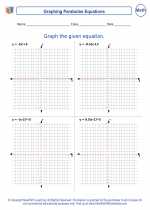Nonlinear Functions and Set Theory
Nonlinear Functions
Nonlinear functions are a type of mathematical function that do not form a straight line when graphed on a coordinate plane. Unlike linear functions, which have a constant rate of change, nonlinear functions have varying rates of change.
Types of Nonlinear Functions
- Quadratic Functions: These functions are in the form f(x) = ax^2 + bx + c, where a, b, and c are constants and a ≠ 0. The graph of a quadratic function is a parabola.
- Exponential Functions: These functions are in the form f(x) = a * b^x, where a and b are constants and b is the base. The graph of an exponential function is a curve that increases or decreases rapidly.
- Logarithmic Functions: These functions are the inverse of exponential functions and are in the form f(x) = log_b(x), where b is the base. The graph of a logarithmic function is a curve that increases or decreases slowly.
- Other Nonlinear Functions: There are many other types of nonlinear functions, such as rational functions, radical functions, and trigonometric functions.
Set Theory
Set theory is a branch of mathematical logic that studies sets, which are collections of objects. In set theory, the objects within a set are called elements, and sets can be defined by listing their elements or by using set-builder notation.
Key Concepts in Set Theory
- Union and Intersection: The union of two sets A and B, denoted by A ∪ B, is the set of all elements that are in A, in B, or in both. The intersection of two sets A and B, denoted by A ∩ B, is the set of all elements that are in both A and B.
- Subsets and Proper Subsets: A set A is a subset of a set B if every element of A is also an element of B. If A is a subset of B and A is not equal to B, then A is a proper subset of B.
- Complement: The complement of a set A, denoted by A', is the set of all elements in the universal set that are not in A.
- Universal Set: The universal set, denoted by U, is the set that contains all the elements under consideration in a particular context.
Study Guide
Here are some tips for studying nonlinear functions and set theory:
- Review the properties and graphs of quadratic, exponential, and logarithmic functions.
- Practice solving equations involving nonlinear functions and interpreting the solutions in real-world contexts.
- Work on problems involving union, intersection, subsets, and complements of sets in set theory.
- Use Venn diagrams to visualize relationships between sets and their operations.
- Understand the concept of the universal set and its role in defining subsets and complements.
- Explore applications of nonlinear functions and set theory in various fields, such as science, economics, and engineering.
By mastering the concepts and practicing problems related to nonlinear functions and set theory, you can develop a solid understanding of these topics and enhance your problem-solving skills in mathematics.
.◂Math Worksheets and Study Guides Seventh Grade. Nonlinear Functions and Set Theory

 Worksheet/Answer key
Worksheet/Answer key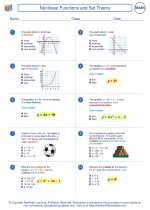
 Worksheet/Answer key
Worksheet/Answer key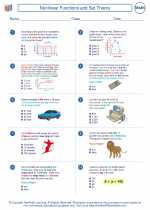
 Worksheet/Answer key
Worksheet/Answer key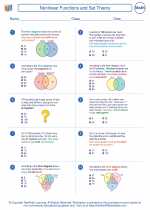
 Worksheet/Answer key
Worksheet/Answer key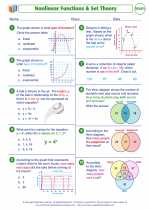
 Worksheet/Answer key
Worksheet/Answer key